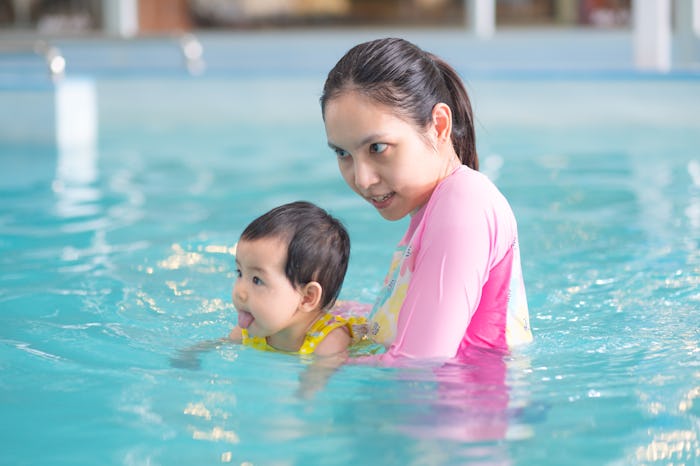Summer is but a memory now, but that doesn’t mean that you or your child might not come into contact with water at some point soon. The fact of the matter is that teaching your baby to hold their breath underwater can save their life.
Because the sad reality is that kids can (and do) drown. It’s truly a sobering statistic: About 350 people die each year from accidental drowning, the Centers for Disease Control and Prevention reported. About one in five people who drown are kids ages 14 and under. And for every one child who dies, five others are treated in the emergency room for almost drowning.
Which is why you should teach your child to swim sooner rather than later. The American Academy of Pediatrics recommends that children ages four and older learn how to swim. Although they have warned against trying to teach younger kids how to swim, they’ve eased up on their guidelines to now recommend that children ages 1-4 might benefit from taking a swim class — but only if they have frequent exposure to water, and possess the emotional and physical capabilities to be able to swim.
But swimming starts by learning how to hold your breath underwater. These tips can help teach your little guppy how to handle herself in the water — and allow you to take a deep sigh of relief, too.
1Blow Bubbles
You don’t have to plunge your precious baby underwater for her to learn how to hold her breath. In fact, she can begin learning how to do so on dry land. Start by blowing some air into your child’s face. “That allows your baby to have that reflex of closing her eyes and holding her breath for a second,” Lindsey Marx, a professional swim instructor in Provo, UT, and a member of the Masters Swim Team, tells Romper. And if you’re at a pool and blow some air bubbles at your babe, you can then gently dunk her underwater so she learns how to hold her breath better.
2Focus On Breathing
Controlling breath is key to ultimately learning how to swim, the Sunsational Swim School reported. With your child at your side, take deep breaths in and make sure he sees your belly expand to reinforce the point that you’re taking in air. Then, blow it back out, making your lips wiggle like you’re making raspberries. And above all, avoid gasping for air, since that might scare your child or make her think that’s how she should breathe under water.
3Practice In The Tub
Too cold to play at the pool? Make some waves by taking a trip — to the tub, that is. Turn bath time into an opportunity to teach your child how to hold her breath underwater, advises Marx. Keep the water somewhat shallow so she can put her face in the water without worrying about diving too deep.
4Fight The Fear
The last thing you want to do is transfer your fear onto your child. So while you might have a momentary freak out when you see your baby being submerged under water, try to stay calm. “Your child will not like learning at first because it is scary,” says Marx. “So practice often and reward her immediately after going under water so she doesn’t develop a fear of the water.”
5Make Frequent Trips To The Water
In order to get your child accustomed to the water (and to forego any fear she might have), give him ample opportunities to learn how to hold his breath as he learns how to swim. “By regularly swimming with your child, it will become a habit and she will eventually learn to hold her breath,” says Marx. So when winter makes it too cold to splash in the waves, you should look for places with an indoor pool, like your local YMCA, where you and your child can practice breathing—and bond together, too.
Teaching your toddler how to hold her breath is going to take some time and patience. But before you know it, your little fishie will be fine in the water and making waves as she swims like a pro.
